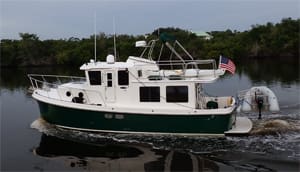For centuries, mariners have depended on a compass to provide direction. Sure, you can get some good approximations of east and west through sunrise and sunset, and you may have studied the constellations overhead to confirm your course at night, but relying on a simple compass for course heading is a relatively foolproof navigational tool that has stood the test of time. Some trawler builders don’t actually mount a proper compass in the pilothouse or on the flybridge — they consider a compass to be an option. A magnetic compass is not an “extra” to me; I want that instant reference to confirm my heading.
Who needs a compass? The first priority for any offshore voyager is to know where you are. Thanks to GPS, radar and other navigational electronics, it is much easier these days to determine precise locations via digital latitudes and longitudes. Knowing where you are enables you to select where you are going, and that is where a compass can help you establish direction and the correct course to travel to reach your next waypoint. So, the answer is: You need a compass!
Whether you are hand-steering or using an autopilot, you need to verify your direction. Glancing at your compass heading is so easy and intuitive. Don’t neglect this tool; it is the easiest way to know you are on course. The route you have plotted takes you from waypoint to waypoint, but I always like to double-check that I’m heading in the correct direction by cross-referencing my compass with my instrument displays. In the pilothouse, the compass globe is typically mounted on centerline; it’s easy to line up the lubber line on the outer rim with the pin in the center of the card and a burgee staff on your bow pulpit in order to create a visual straight line that will confirm your numerical heading as read on the compass card.
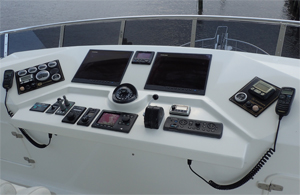 |
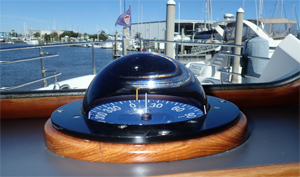 |
|
|
Left, a compass on a trawler’s flying bridge; right, a pilothouse-mounted unit lines up with the bow. |
||
These days it seems that compasses, like clocks, are not as common — mostly because they are often incorporated into other devices. I don’t wear a wristwatch anymore because my smartphone tells me the time of day (and it also has a compass app included). What every offshore voyager needs to consider is your backup solution if things break or fail. Being analog, your compass should survive navigational nightmares like lightning strikes that can render some, if not all, of your nav/comm digital electronics out of service. I find a magnetic compass in the pilothouse a comforting safety reminder when I’m underway, and they tend to become even more important when visibility is diminished at night or in fog.
In our computer/tablet/smartphone information age, we seem to have become less reliant on traditional paper charts and place our trust into the digital world of electronic chartplotters. Don’t treat the idea of having a compass as an afterthought — it truly is an essential piloting tool. So many current electronics displays depend on internal compasses, such as a fluxgate heading sensor that is connected to your autopilot to provide directional heading input to your steering.
Compasses rely on polar magnetism to position the needle. One sure-fire way to disrupt the accuracy of your compass is by placing (usually unintentionally) a large metal object, like a wrench, in close proximity. The metal mass interrupts the natural magnetism. You need to be careful about putting anything comprised of metal near any compass. Typically, autopilot compasses (rate gain or fluxgate) are tucked out of sight somewhere on the boat that will be away from pots and pans or other heavy metal items. It’s not uncommon to see these sensors installed below the master stateroom bed, in an under-sole compartment or underneath the pilothouse dash console. I advise my clients to make discovering the location of the autopilot compass a priority and suggest they identify it with a label. If you are getting some erratic headings affecting your steering, it could be from a metal item near where your autopilot steering compass is installed.
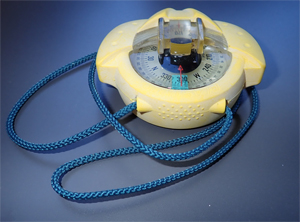 |
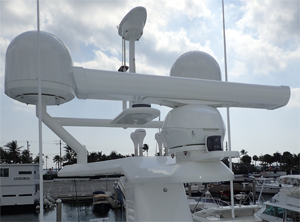 |
|
|
Left, a hand-bearing compass is good for keeping track of nearby traffic; right, a GPS compass antenna mounted at the highest point of an antenna array. |
||
Many of the more sophisticated offshore cruisers, especially those who cross oceans, will outfit their trawler with a GPS/satellite compass (installed up high on deck with an unobstructed view to the sky) to provide headings. These are incredibly accurate as long as the satellites are behaving.
For a permanently installed compass, I like to have one that I can easily see, with large numbers and with a light built in to illuminate the card when running at night. You can use your compass to verify headings and interpret the bearing of surrounding vessels to help you determine if you are clearing them (ahead or behind) or on an intersecting (collision) course. Plotters with ARPA, MARPA and AIS input can provide you instant calculations to yield closest possible approach distances and the time to closest possible approach. These are incredibly helpful, especially if you are piloting through a field of targets.
The accuracy of a compass card can fluctuate based on changes in latitudes. There is an almost lost trade of skilled compass adjusters who can come to your boat and make sure that the deviations are correct for the cruising waters where you’re traveling. The adjuster will take your boat out in open water to “swing” your compass by cycling your boat through a few circles and then comparing the results with a properly adjusted master compass. They use magnets and compensator rods for adjustments, and provide a deviation card that you should keep for reference.
Having a hand-bearing compass readily available in your wheelhouse is another smart idea. I prefer the simple “hockey puck” type. These aren’t permanently affixed, so they allow you to move around and inspect neighboring traffic to calculate range and bearing.
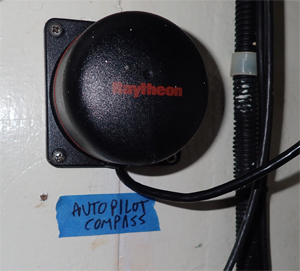 |
|
An autopilot fluxgate compass. |
Some binoculars have a compass reference incorporated within so you can look through the long eyes and verify headings and directions of vessels that are nearby.
Your dinghy/tender should also be outfitted with a compass.
The compass is one of the original nav tools. They are reliable when adjusted and still relevant today. Should you have a compass ready and available at primary steering stations? Of course!
Jeff Merrill, CPYB, is the president of Jeff Merrill Yacht Sales, Inc.- www.JMYS.com. He is a veteran yacht broker providing individual attention and worldwide professional representation to buyers and sellers of recreational tugs and trawlers. He also has a popular YouTube channel. Merrill is active as a public speaker and writer, and enjoys spending time at sea with clients. He has written several articles for Ocean Navigator’s Power Voyaging column. Email Merrill at Jeff@JMYS.com.

